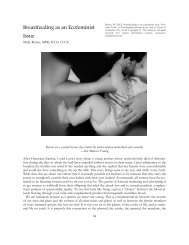RE:IJSNC, Issue 1, Volume 2, May 2012 - Ocean Seminary College
RE:IJSNC, Issue 1, Volume 2, May 2012 - Ocean Seminary College
RE:IJSNC, Issue 1, Volume 2, May 2012 - Ocean Seminary College
You also want an ePaper? Increase the reach of your titles
YUMPU automatically turns print PDFs into web optimized ePapers that Google loves.
Restoration Earth: An Interdisciplinary Journal for the Study of Nature & Civilization, 1(2)<br />
These words speak of both nature and sexuality.<br />
Unlike the later patriarchal demeaning of women,<br />
sexuality and nature, these expressions do not demean<br />
natural forces and expressions—but rather<br />
both claim and honor their abundant expression.<br />
Most women understand maternal qualities, and<br />
have also experienced passion and sensuality—but<br />
how many women have experienced the journey<br />
into the underworlds to confront the power of<br />
their dark sister? The hymn describing Inanna’s<br />
journey into the depths of the underworld, where<br />
she is killed by her dark sister Ereshkigal is a story<br />
of both meeting and being consumed by power. It<br />
is also a story of death and resurrection 7—a journey<br />
leading to integration and wholeness. When<br />
Inanna returns, she confronts the fact that her consort<br />
Dumuzi has taken over her throne. She then<br />
replicates Ereshkigal’s power as Inanna banishes<br />
Dumuzi and claims her position—a throne she can<br />
hold with or without her lover. Although there are<br />
other renditions 8 of this Sumerian legend, I believe<br />
this version speaks to what happened as patriarchy<br />
robbed women of their equality in life. It also illuminates<br />
the work that women need to accomplish<br />
in order to reclaim their inherent royalty as we are<br />
all expressions of divine life and as such automatically<br />
have equality (more on thrones later in the<br />
article).<br />
In the beginning of this story, Inanna starts a<br />
journey based on compassion. She has learned that<br />
her sister, Ereshkigal, queen of the underworld, is<br />
suffering for the loss/death of her consort. Inanna<br />
wants to comfort her sister despite the warnings of<br />
those around her. It is said that the journey into<br />
the underworld is a dangerous one—and that it<br />
could bring on her death. But Inanna is determined<br />
to go to her dark sister. She does concede their<br />
warnings in that she tells her devoted servant Ninshubar<br />
to take some form of action if Inanna has<br />
not returned in three days—for it is the law of the<br />
underworld that one cannot leave after entering it.<br />
Inanna descends through the seven gates into the<br />
underworld, explaining that she is going to Ereshkigal’s<br />
realm in order to mourn the loss of Ereshkigal’s<br />
husband. At each gate she then relinquishes<br />
her royal garments and jewels until, after passing<br />
the final gate, Inanna enters the realm of Ereshkigal,<br />
naked and stooped over. Inanna begins the<br />
26<br />
journey with the intent of bringing comfort to her<br />
sister, but it is not received. Instead, Inanna is met<br />
with her sister’s destructive power.<br />
Although this story has strong elements of a shamanic<br />
journey, it is also a powerful metaphor about<br />
knowing the feminine power hidden in the underground<br />
of our inner beings. As long as this innate<br />
power is unconscious it can act in destructive ways.<br />
Perhaps the recognition of it has the capacity to destroy<br />
the limited image previously held of one’s self<br />
as a woman—a recognition that can precipitate a<br />
rebirth leading to wholeness. We must bring our<br />
power out of the shadows. The balance of beauty<br />
and power is the wholeness that is needed in order to<br />
heal our fractured and endangered world. 9<br />
During the late 80s, I was doing a lot of healing<br />
breath work. I began seeing that unconscious emotions,<br />
and also great depths of power, were hidden<br />
within the body. When the breath is focused it can<br />
stimulate neural networks and power centers. Cellular<br />
memories, primal, instinctual energies, can awaken<br />
the body–mind from its unconscious slumber<br />
(Thurman, 1994; Washburn, 1994; Mijares, <strong>2012</strong>).<br />
Memory is inherent within the genes and cellular<br />
structures of DNA. This memory contains the stories<br />
of our genetic ancestors and those of the collective<br />
unconscious. These memories also contain dramas<br />
depicting human pathos. They are teeming with narratives<br />
of destruction, power, and beauty. Repressed<br />
feelings, memories, ego-states, sub-personalities, and<br />
archetypal forces can be hidden in energy blocks. In<br />
short, deep forces were awakening within me.<br />
Because I had been raised in a very violent and<br />
unloving family, I did not know how to speak up for<br />
myself nor had I learned to value my feelings. Although<br />
I had much compassion for others, coupled<br />
with a deeply rooted sense of integrity and responsibility,<br />
I did not know how to protect my boundaries<br />
in difficult relational experiences. One day I was going<br />
over to my friend’s house to pick up some papers.<br />
She was an older woman who had taken the<br />
time to teach me much of what she had learned as an<br />
editor for a major publishing house, but she was also<br />
a domineering woman—who would drain others<br />
with lengthy conversations about her past. That day<br />
had been a particularly difficult one, and so I told her<br />
I would not be able to stay and chat. She immediately<br />
began to dominate the situation, and my time. Sud-



